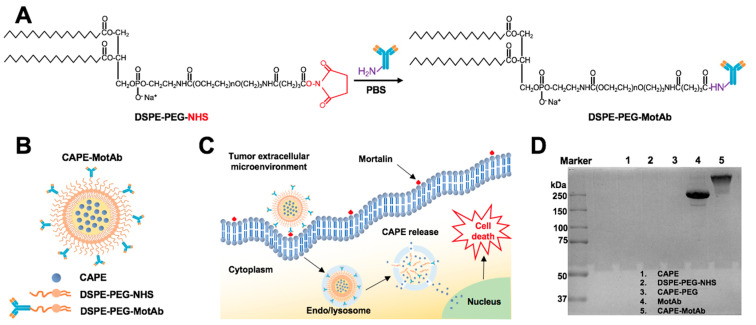Figure 1.
Schematic illustration of the construction and characteristics of CAPE-MotAb nanoparticles for targeted drug delivery. (A) MotAb modified with DSPE-PEG-NHS. (B) Structure of mortalin-targeted CAPE-MotAb nanoparticles formed by self-assembly of amphiphilic block copolymers (DSPE-PEG-NHS) with MotAb. (C) General mechanism of targeted action by CAPE-MotAb for cancer treatment: the nanocapsules with long blood circulation times get accumulated at the tumor region through passive targeting achieved by EPR effect and subsequently internalized by tumor cells via mortalin-mediated endocytosis. The low pH in endo/lysosomes offers an optimal environment to facilitate the CAPE escape to the cytoplasm by decomposing micelles, thus resulting in cell death. (D) Non-reducing SDS-PAGE analysis of CAPE, DSPE-PEG-NHS, CAPE-PEG, MotAb, and CAPE-MotAb. MotAb appeared at MW ~250-kDa, CAPE-MotAb was seen at higher molecular weight suggesting the successful conjugation of MotAb to DSPE-PEG-NHS. (E) UV-Vis-NIR absorption spectra of CAPE-MotAb. Characteristic peaks of MotAb at 280 nM and CAPE at 335 nM (marked with black arrows) were simultaneously observed in CAPE-MotAb showing successful encapsulation of CAPE in polymeric micelles. (F) Representative TEM image of CAPE-MotAb (a magnified inset is shown in the top right corner). (G) Quantitative size distribution of CAPE-MotAb shown as monodisperse and spherical in shape with a diameter ranging from 9 to 19 nM.


